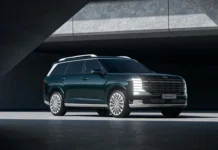The second-generation 2025 Porsche Macan is going in an entirely new direction to the original.
A few days after teasing the all-new version of its popular SUV, Porsche finally shed most of the technical details in Singapore Thursday. Unlike the original version that launched a decade ago, this new Macan doesn’t just change it up in terms of styling — it’s getting an electric powertrain as well.
In terms of exterior styling, this new model borrows key cues from the Taycan like the four-LED daytime running lights, while designers also gave it more of a coupe-like rear profile and full-width light bar across the rear. Overall, the new Macan measures out to 188.4 inches long, 84.7 incheswide and 63.8 inches high, ridding on a 113.9-inch wheelbase (that’s 3.4 inches longer than the old gas model).
Two versions of the 2025 Porsche Macan made their debut: the entry-level Macan 4 and the more potent and expensive Turbo. The latter brings a whopping 630 horsepower and 833 lb-ft of torque to the table, enabling a 0-60 time of 3.1 seconds. For folks who choose not to stretch their budget to the performance version, the base Macan 4 still manages 402 horsepower and 479 lb-ft of torque, which Porsche says still allows a 0-60 spring in a respectable 4.9 seconds. The top speeds of these all-electric Macans shake out to 136 and 161 mph, respectively.



The 2025 Porsche Macan utilizes a 100-kWh gross capacity battery pack, with 95-kWh of usable energy. Like with the Taycan, Porsche developed its all-electric SUV on the Premium Platform Electric (PPE) architecture, giving the car an 800-volt electrical architecture and DC fast-charging capability up to 270 kW, where the infrastructure allows it. On the range front, Porsche is targeting about 310 miles (or 500 km), though no official EPA figures are out on the new Macan just yet. Regenerative braking does allow up to 240 kW of power back into the batteries, though we’ll need to test just how much that effects the range in a long-distance drive. Under ideal conditions, the new Macan can charge up from 10-80% state-of-charge in about 21 minutes. The new Macan also has an 11-kW onboard AC Level 2 charger.
Both versions of the 2025 Porsche Macan are dual-motor and all-wheel drive, with the Turbo getting Porsche Torque Vectoring Plus, which adds an electronically-controlled differential lock on the rear axle.
If you do want to tow with the all-electric Macan, Porsche says it can handle up to 4,409 pounds of total capacity, when properly equipped.

Looking inside the new Macan
Inside, the 2025 Porsche Macan shares familiar styling cues to the rest of the brand’s most recent offerings. You get a 10.9-inch digital gauge cluster as well as a 12.6-inch infotainment display. The optional passenger screen also measures out to 10.9 inches. Porsche’s latest Android-based infotainment system features in the new Macan, and does provide Apple CarPlay support as well as obviously supporting phones running Google’s OS.
Depending on how you spec it, the 2025 Porsche Macan has both front occupants sitting 1.1 inches lower than before, while rear passengers sit 0.6 inches lower and have better legroom. In terms of cargo capacity, the new Macan offers up to 18 cubic feet with the rear bench in place. Fold it down, and that capacity increases to 46.5 cubic feet. And if you’re asking “does it have a frunk?”, it absolutely does. Thanks to the 2.9 cubic feet of extra space under the hood, this new SUV has about 4.4 cubic feet greater overall cargo capacity than the gas version.

How much will it cost?
While we don’t have official range figures, we do (surprisingly) have pricing for the 2025 Porsche Macan. The automaker says the entry-level Macan 4 will launch with an asking price of $80,450 (including Porsche’s $1,650 destination fee). As for the Macan Turbo, you’ll have to spend at least $106,950 before options.
EPA figures will be available closer to the launch date. Order books for the 2025 Porsche Macan are open now, with the first deliveries to U.S. customers set to kick off in the second half of this year.
























